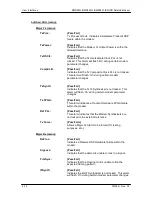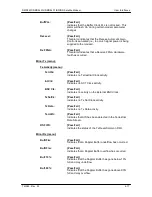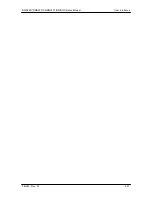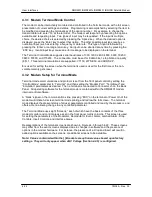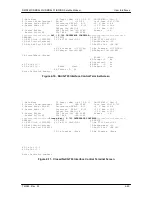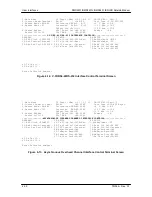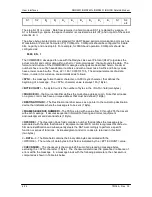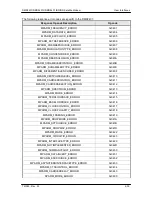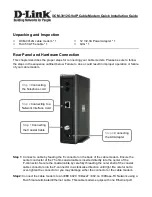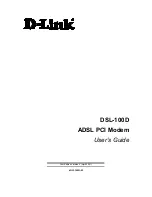
User Interfaces
DMD2401/DMD2401L/DMD2401 IBS/IDR Satellite Modem
4-24
TM065 – Rev. 3.3
4.3.1 Modem Terminal Mode Control
The modem can be interactively monitored and controlled in the Terminal mode, with a full screen
presentation of current settings and status. Programming is accomplished by selecting the item to
be modified and pressing the terminal key of the option number. For example, to change the
transmit data rate, enter ‘33’ at the terminal. The modem will respond by presenting the options
available and requesting input. Two types of input may be requested. If the input is multiple
choice, the desired choice is selected by pressing the ‘Space’ key. When the desired option is
displayed, press the ‘Enter’ key to select that option. The other possible input type requires a
numerical input (such as entering a frequency or data rate. This type of input is followed by
pressing the ‘Enter’ or carriage return key. An input can be aborted at any time by pressing the
‘ESC’ key. Invalid input keys cause an error message to be displayed on the terminal.
The Terminal Control Mode supports serial baud rates of 300, 1200, 2400, 4800, 9600, 19200,
38400, 57600, and 115200. The connection must be set for 8 data bits, 1 stop bit and no parity
(8,N,1. Three terminal emulations are supported: VT100, WYSE 50, and ADDS-VP.
$ is used for setting the screen when the terminal is used is used for the first time or the non-
volatile memory gets reset.
4.3.2 Modem Setup for Terminal Mode
Terminal mode communications and protocol is set from the front panel control by setting the
“Control Mode” parameter to “Terminal”, and then setting the “Modem Port,” “Term Baud” and
“Emulation” parameters as desired. Then a terminal is connected to Connector J5 on the Back
Panel. All operating software for the terminal mode is contained within the DMD2401 modem
internal control software.
A “break” signal on the communications line, pressing “ESC” on the terminal or Power On of the
modem will initiate full screen terminal mode printing and redraw the full screen. The terminal
mode displays the present status of all user parameters controlled and read by the processor, and
offers a menu allowing change to any controlled parameter.
The Terminal Mode uses eight “Screens,” each of which have the basic contents of the three
modem monitor and control areas as set in the front panel matrix columns. This screen is used
for setting the parameters of the Modulator, Demodulator, Event, Alarm, Latched Alarm, Drop
Controls, Insert Controls, and Interface Areas.
Representations of the terminal screens are shown in Figures 4-3 through 4-22. These screens
may differ from the exact screens displayed due to changes in software and the presence of
options in the modem hardware. For instance, the presence of a Drop and Insert will result in
added options available on the screens, or additional screens to be available.
Note: Values contained within the [ ] Brackets are optional values based upon factory
settings. They will only appear when AGC Voltage (Section 4.2.5) is configured.
Summary of Contents for DMD2401 IBS
Page 2: ......
Page 15: ......
Page 60: ...DMD2401 DMD2401L DMD2401 IBS IDR Satellite Modem User Interfaces TM065 Rev 3 3 4 21...







